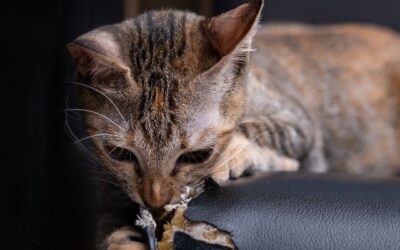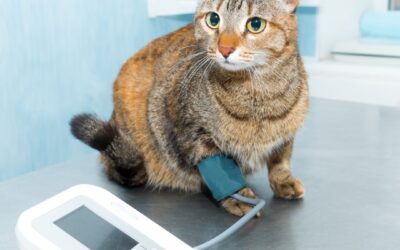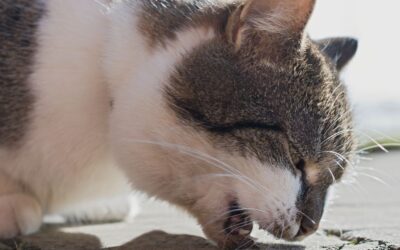Caring for a pregnant cat? Make this beautiful experience special with 5 helpful tips to keep the feline mom-to-be healthy and happy:
- Feed a feline pregnancy-specific, well-balanced diet.
- Visit the vet frequently for examinations and advice.
- Create a comfortable, secure environment for nesting.
- Encourage mild exercise and mental stimulation for a happy mom-to-be.
- Keep an eye on mood and appetite and be there for comfort as your furry friend needs.
Read on to explore every tip in detail.
This article covers the fundamentals of taking care of a pregnant cat, from comprehending cat pregnancy in general to setting up a cozy kittening space and providing nourishing food.
First Things First: How to Know if a Cat is Pregnant?

Week 1: In the first week of pregnancy, several changes happen on a microscopic level. These are not visible externally – physically or behaviourally but a lot of changes on a hormonal level.
Week 2: Some cats may exhibit subtle changes like increased affection or become more reserved. Some may start displaying nesting behavior like finding a quiet spot. For some, appetite may increase. A vet examination can confirm cat pregnancy in Week 2.
Week 3: In the third week, the cat’s nipples become more enlarged, pinker, and may have small bumps called pinking up. The abdomen will start enlarging. Behavioral changes may happen like seeking more attention or finding comfortable spaces.
Week 4: The cat will continue to gain weight; the abdomen will enlarge further. She may show enthusiasm for food. Mammary glands will become prominently large (firmer to touch), and nesting behavior will increase.
Week 5: The ‘queen’ will be quite restless in this week as the due date is approaching. She would keep her nesting spot ready with some comfortable bedding. Mammary glands will produce colostrum. The abdomen will continue to enlarge, and become rounder and heavier. She will want to eat more and more now. She will be extremely protective of her nesting spot. Only her most-trusted humans will be given access to this spot (rarely happens though!)
Awareness of these stages is crucial for you to provide good cat care. Once you identify that your cat is going to be a mommy, be there for her ONLY when she needs it – giving them space, especially at this time, is important!
The typical length of cat pregnancy is 63 to 65 days. Once you’re sure about your cat’s pregnancy, here are some things you should do to keep her healthy and comfortable.
Basic Care for A Pregnant Cat

Comfort Comes First
A pregnant cat needs a calm atmosphere. Reduce jarring sounds, abrupt movements, and other distractions that can make her nervous. Give her a peaceful, warm, and comfortable place to rest. Maintain a spotless, easily accessible litter box for her, and make sure fresh water is constantly accessible to her.
Handling A Pregnant Cat
Despite the need to nurture and comfort a pregnant cat, it’s best to refrain from handling her too much. To avoid putting undue strain on her body, pick her up gently and support her back. Keep any physical activity to a minimum and let her relax comfortably.
Caring for the Basics – Food, Litter, Water, Health
The health of a pregnant cat and the growth of her developing kittens depend on a proper diet. A cat’s nutritional requirements alter during pregnancy, so it’s necessary to provide her with well-balanced food that matches her needs. Here are some important things to consider:
Transit To Specialized Cat Food
Switch your pregnant cat to premium cat food that is made especially for a pregnant cat. They are formulated specially to give the mother the nutrition she needs to stay healthy and to help the developing kittens grow to their full potential. To choose the brand and composition of cat food that is best for your cat, speak with your vet. We recommend Royal Canin’s Mother and Baby Cat Dry Food as it has a highly-digestible, high-quality kitten/growth/development formulation.
Essential Nutrients
To promote their own health and the development of the kittens, a pregnant cat needs higher levels of nutrients. High-quality proteins, vital fatty acids like omega-3 and omega-6, vitamins, and minerals are some of these nutrients. These nutrients are included in the right amounts in the specially-made cat chow for felines that are expecting or nursing.
Feeding Guidelines and Portions
Follow the feeding instructions provided by your vet, and divide the daily suggested portion into small meals spread out throughout the day. In order to ensure your pregnant cat is getting enough food, it is preferable to give her smaller, more frequent meals because she may experience a lower appetite during the early stages of pregnancy.
Regular Veterinary Care
Visit a veterinarian on a regular basis throughout pregnancy to assess your cat’s health and nutritional state. Your pregnant cat’s special nutritional requirements can be met by your veterinarian, who will also take into account your cat’s age, general health, and the number of kittens she is carrying.
Fresh Water Availability
Always make sure that your pregnant cat has access to fresh, clean water. She must stay hydrated for both her general health and the nursing stage’s milk production.
Litter-box Availability
Place the litter box in a peaceful, crowd-free area where your pregnant cat can feel safe and enjoy some privacy. Numerous litter boxes improve the likelihood that the pregnant cat will locate a box quickly when she wants to relieve herself. Additionally, it lessens the likelihood of overpopulation or rivalry between different cats living in the same home. Pick a litter box that is at least 1.5 times as long as your cat to allow it to move around comfortably. Because pregnant cats may be more sensitive to changes at this time, avoid making abrupt changes to the type of litter. Choose a litter that is safe for both the pregnant cat and her kittens, whether it be clumping or non-clumping.
Behavioral Changes
During pregnancy, the cat goes through several behavioral changes. Understanding these changes will help you provide the necessary care and support during this crucial time.
Affectionate Behaviour
Many pregnant cats exhibit more loving behavior toward their owners. They might become more needy, love to be caressed, and spend more time near their human friends.
Nesting Behaviours
Your pregnant cat may display nesting behaviors as the due date draws near. She might begin looking for a suitable location to give birth, perhaps poking around in cozy areas of the house or quiet nooks. To facilitate this innate behavior, a specialized nesting box can be provided.

Here’s how to create the perfect nesting box:
- Choose a spacious and sturdy box.
- Line it with soft bedding.
- Provide warmth with a heating pad or towel-wrapped heating disk.
- Place the box in a quiet, private area.
- Create an easy-access entrance.
- Keep the box clean and fresh.
- Offer food and water nearby.
Mood Swings
Pregnancy hormones can make cats experience mood swings that result in behavioral changes. While some cats could become more agitated or easily frightened, others might exhibit clinginess or occasionally seek isolation.
Increased Vocalisation
A pregnant cat may voice herself more. They might meow more frequently or use other vocalizations to express their needs and pain. Pay attention to these signals and offer consolation or assurance if required.
Assisting the Delivery
Although the majority of cats can give birth naturally, it is still important to be ready and aware of the procedure. Keep a watch on your cat as her due date approaches in order to spot any indications of labor. These symptoms could include pacing, restlessness, excessive genital grooming, hunger loss, and nesting behavior. Watch her carefully without intruding excessively, since some cats prefer privacy while giving birth. When helping with the delivery, keep the following in mind:
Set Up Serene Environment
Make sure the birthing space is serene, quiet, and devoid of any disturbances. Reduce any human interaction, loud noises, and abrupt movements that can upset the pregnant cat. Giving her a private area where she feels secure and safe will aid in quick delivery.
Allow your Cat to Lead
It’s important to keep in mind that cats are instinctive and can typically manage the birthing process without assistance from humans. Give the cat the reins and let her act according to her instincts. As the labor process proceeds, she may assume several positions, such as lying on her side or back.
Provide Help in Emergencies
While most cat deliveries go without a hitch, difficulties might sporadically occur. Contact your veterinarian right away if you see lengthy or powerful labor contractions without the delivery of a kitten, significant blood, signs of concern, or if the cat seems to be in discomfort. They can suggest calling for advice or bringing the cat in for an urgent assessment.
You can provide your pregnant cat the proper care, support, and assurance throughout her pregnancy by observing and comprehending these subtle changes. Always seek professional assistance and advice from your veterinarian if you have any questions or detect any unusual symptoms.
New-Born Kitten Care

New-born kittens require extreme care. While most mother cats instinctively take care of their kittens, there may be situations where intervention is necessary. Here are some important points to consider regarding kitten care.
Environmental Setting
- Provide a quiet, warm, and draft-free location for the kittens to nest in order to provide a cozy and secure environment. To keep the kittens from straying, place them in a box or another container with low edges.
- As newborn kittens can’t control their body temperatures, it’s crucial to keep them warm. In a corner of the nesting space, place a heat source, such as a heating pad on low or a warm water bottle covered in a towel.
- Maintain cleanliness – keep the nesting space dry and spotless. To preserve hygiene, replace dirty bedding with fresh, soft materials.
Feeding Instructions
Consult A Veterinarian
Make sure the mother cat has access to a nourishing diet and fresh water if she is nursing the kittens. For particular nutritional advice, speak with your veterinarian.
Feeding Orphaned Kitten
If you are caring for orphaned kittens or the mother cat is unable to nurse, you should see your veterinarian to learn the right bottle-feeding procedures. Use a commercial kitten milk substitute and mix it according to the mixing and feeding directions.
Feeding Intervals
Young kittens need to be fed often, typically every 2-4 hours. Follow your veterinarian’s recommendations for feeding times and serving quantities based on the weight and age of the kittens.
Elimination Assistance
Mother cats usually lick their kittens’ genitalia to get them to urinate and poop.
If you are taking care of orphaned kittens, you will need to imitate this by gently massaging their genital and anal areas with a warm, damp cloth or cotton ball after each feeding. Promote elimination by putting the kittens in a shallow litter box with non-clumping litter or on absorbent puppy pads after stimulation. Give them time to finish the procedure, and be patient.
Health Observation
Veterinary check-ups on a frequent basis are recommended to keep an eye on the kittens’ growth, development, and general health. Their age and health status will be taken into consideration when deciding on vaccination and deworming regimens. Also keep an eye out for any adjustments in look, appetite, or behavior. Make an immediate appointment with your veterinarian if you notice any anomalies or concerns.
Progressive Weaning
Gradually introduce solid food: Around 4-5 weeks of age, start the kittens on a high-quality wet food. Provide little portions on a shallow plate and observe how they react and how much they can consume.
Transition to solid food: Until the kittens are completely weaned, gradually increase the amount of solid food and decrease the frequency of bottle feeding or nursing.
Bonding and Socialization
Gently handle the kittens each day to gradually introduce human contact. This makes it easier for children to interact with people and guarantees that kids acquire effective socialization skills.
Spend time with the kittens, chatting softly and giving them gentle stroking to provide comfort and stability. This builds your bond with the kittens and helps establish trust.
Remember that every kitten is different and may have different demands. For individualized advice and direction throughout the new-born kitten care procedure, speak with your veterinarian. The new-born kittens can thrive and develop into healthy cats with the right care, love, and attention.





0 Comments